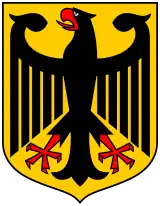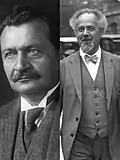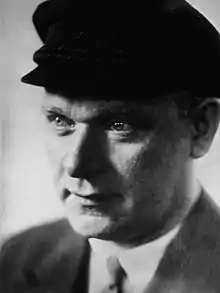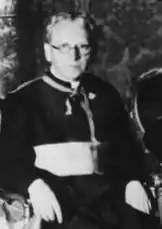| |||||||||||||||||||||||||||||||||||||||||||||||||||||||||||||||||||||||||||||
All 577 seats in the Reichstag 289 seats needed for a majority | |||||||||||||||||||||||||||||||||||||||||||||||||||||||||||||||||||||||||||||
|---|---|---|---|---|---|---|---|---|---|---|---|---|---|---|---|---|---|---|---|---|---|---|---|---|---|---|---|---|---|---|---|---|---|---|---|---|---|---|---|---|---|---|---|---|---|---|---|---|---|---|---|---|---|---|---|---|---|---|---|---|---|---|---|---|---|---|---|---|---|---|---|---|---|---|---|---|---|
| Registered | 42,982,912 ( | ||||||||||||||||||||||||||||||||||||||||||||||||||||||||||||||||||||||||||||
| Turnout | 82.0% ( | ||||||||||||||||||||||||||||||||||||||||||||||||||||||||||||||||||||||||||||
| |||||||||||||||||||||||||||||||||||||||||||||||||||||||||||||||||||||||||||||


| |||||||||||||||||||||||||||||||||||||||||||||||||||||||||||||||||||||||||||||
| |||||||||||||||||||||||||||||||||||||||||||||||||||||||||||||||||||||||||||||
| This article is part of a series on the |
| Politics of Germany |
|---|
 |
Federal elections were held in Germany on 14 September 1930.[1][2] Despite losing ten seats, the Social Democratic Party of Germany (SPD) remained the largest party in the Reichstag, winning 143 of the 577 seats, while the Nazi Party (NSDAP) dramatically increased its number of seats from 12 to 107.[3] The Communists also increased their parliamentary representation, gaining 23 seats and becoming the third-largest party in the Reichstag.
Background
The Social Democratic Party of Germany (SPD) had won the most votes and was the largest party in every election from 1919 to 1930. They led the coalition government between 1919–1920 and 1928–1930.
After the 1928 German federal election, a grand coalition was formed under the Social Democratic chancellor Hermann Müller. The coalition collapsed on 27 March 1930. President Hindenburg appointed Centre Party politician and academic Heinrich Brüning as chancellor, who formed a minority government.
The new government was confronted with the economic crisis caused by the Great Depression. Brüning disclosed to his associates in the German Labour Federation that his chief aim as chancellor would be to liberate the German economy from the burden of continuing to pay war reparations and foreign debt. This would require an unpopular policy of tight credit and a rollback of all wage and salary increases (an internal devaluation). The Reichstag rejected Brüning's measures within a month, who then used emergency powers to pass it anyway. The Reichstag rejected the emergency decree with 256 votes from the Social Democrats, the Communists, the German National People's Party and the Nazis. Brüning asked Hindenburg to dissolve the Reichstag, who promptly did so on 18 July 1930. New elections were held on 14 September 1930.
Electoral system
In 1930, Germany was formally a multi-party parliamentary democracy, led by President Paul von Hindenburg (1925–1934). However, beginning in March 1930, Hindenburg only appointed governments without a parliamentary majority which systematically governed by emergency decrees, circumventing the democratically elected Reichstag.
The electoral law awarded one seat in the Reichstag per 60,000 votes. All citizens over 21 could vote through a system of proportional representation. A new parliament was elected every four years to deal with issues related to taxes, trade, defense, etc. The President was directly elected every seven years and was primarily in control of the armed forces; however, he also had significant powers to dissolve the Reichstag, nominate a Chancellor, veto laws, and invoke article 48.
Campaign
The Nazis had increased their share of the vote in state elections since their 1928 federal election result.[4] In spring 1930, Adolf Hitler appointed Joseph Goebbels as the head of the party's Propaganda Division and Goebbels oversaw the party's Reichstag campaign.[5]
The SPD designated the "bourgeois block" and the Nazis as their enemies and, with the KPD, held rallies in Berlin on 1 August 1930 under the motto "Never again war". Some 30,000 participated in the SPD rally in the Lustgarten and 15,000 in the KPD demonstration at the Winterfeldtplatz. On 23 August, KPD members attacked a Nazi event in Bunzlau. Three people were killed and two seriously injured in fighting with the police. The KPD election campaign climaxed with a rally in the Berlin Sportpalast on 12 September.
Results
The election had a voter turnout of 82%, the highest since the 1919 election.[6] The Social Democratic Party of Germany (SPD) remained the strongest party and won 143 seats, a loss of 10 seats from the previous election. The National Socialist German Workers Party (NSDAP) rose to become the second-largest party with 18.25% of the vote and gained 107 seats, a massive increase from the 12 seats that had been gained in the last election. The only other major party to significantly increase its seats was the Communist Party of Germany, which won 13.13% of the vote, securing 77 seats, 23 more than in the last election. The Centre Party slightly increased their seat count by 7, equalling 68, but dropped to fourth from third place in their seat count and popular vote in comparison to the 1928 election.
The German National People's Party's (DNVP) support plummeted but managed to secure 41 seats overall. They lost 32 seats from their previously held 73, and dropped to fifth from second, chiefly due to the fragmentation of the party under Alfred Hugenberg's leadership.[7] Due to Hugenberg's more hardline positions, moderate voters moved to the newly-formed Christian Social People's Service (CSVD), Conservative People's Party (KVP), and Christian-National Peasants' and Farmers' Party (CNBL).[8] The German People's Party (DVP) continued to haemorrhage seats, losing 15 and only attaining 4.51% of the popular vote, ceasing to be a notable political force after the July 1932 elections. The 28 other political parties shared the remainder of the votes.
| Party | Votes | % | +/– | Seats | +/– | |
|---|---|---|---|---|---|---|
| Social Democratic Party | 8,575,244 | 24.53 | −5.23 | 143 | −10 | |
| Nazi Party | 6,379,672 | 18.25 | +15.62 | 107 | +95 | |
| Communist Party of Germany | 4,590,160 | 13.13 | +2.51 | 77 | +23 | |
| Centre Party | 4,127,000 | 11.81 | −0.26 | 68 | +7 | |
| German National People's Party | 2,457,686 | 7.03 | −7.22 | 41 | −32 | |
| German People's Party | 1,577,365 | 4.51 | −4.20 | 30 | −15 | |
| Reich Party of the German Middle Class | 1,361,762 | 3.90 | −0.61 | 23 | 0 | |
| German State Party | 1,322,034 | 3.78 | −1.03 | 20 | −5 | |
| Christian-National Peasants' and Farmers' Party | 1,108,043 | 3.17 | +1.31 | 19 | +10 | |
| Bavarian People's Party | 1,058,637 | 3.03 | −0.04 | 19 | +2 | |
| Christian Social People's Service | 868,269 | 2.48 | New | 14 | New | |
| German Farmers' Party | 339,434 | 0.97 | −0.59 | 6 | −2 | |
| Conservative People's Party | 290,579 | 0.83 | New | 4 | New | |
| Reich Party for Civil Rights and Deflation–Christian Social Reich Party | 271,291 | 0.78 | −0.88 | 0 | −2 | |
| Agricultural League | 193,926 | 0.55 | −0.10 | 3 | 0 | |
| German-Hanoverian Party | 144,286 | 0.41 | −0.23 | 3 | −1 | |
| Christian Social Peoples Community | 81,550 | 0.23 | New | 0 | New | |
| Polish People's Party | 72,913 | 0.21 | 0.00 | 0 | 0 | |
| Schmalix Greater German List | 26,707 | 0.08 | New | 0 | New | |
| German House and Property Owners' Party | 25,530 | 0.07 | −0.05 | 0 | 0 | |
| Conservative People's Party–German-Hanoverian Party | 22,218 | 0.06 | New | 0 | New | |
| Independent Social Democratic Party | 11,690 | 0.03 | −0.04 | 0 | 0 | |
| Free Association of Craftsmen, Retailers, and Tradesmen | 9,531 | 0.03 | New | 0 | New | |
| Radical German State Party | 8,841 | 0.03 | New | 0 | New | |
| German Unity Party for the True National Economy | 6,915 | 0.02 | New | 0 | New | |
| Disabled Veterans and Survivors of the German Side, Including the Found | 6,704 | 0.02 | New | 0 | New | |
| German Cultural Party of Intellectual Professions, Employees and Officials | 6,181 | 0.02 | New | 0 | New | |
| Tradesmen, Craftsmen, Home Owners | 3,644 | 0.01 | New | 0 | New | |
| Schleswig Club | 1,785 | 0.01 | 0.00 | 0 | 0 | |
| Humanity Party and the New Community | 1,626 | 0.00 | New | 0 | New | |
| Evangelical voters | 1,326 | 0.00 | New | 0 | New | |
| Party Against Alcohol | 1,171 | 0.00 | New | 0 | New | |
| Workers Party for Creative Workers | 907 | 0.00 | New | 0 | New | |
| Prussian-Lithunanian People's Party | 666 | 0.00 | New | 0 | New | |
| Renter and People's Reich Party | 653 | 0.00 | New | 0 | New | |
| People's Party of the Lusatian Sorbs | 288 | 0.00 | New | 0 | New | |
| Friesland | 237 | 0.00 | 0.00 | 0 | 0 | |
| Total | 34,956,471 | 100.00 | – | 577 | +86 | |
| Valid votes | 34,956,471 | 99.24 | ||||
| Invalid/blank votes | 268,028 | 0.76 | ||||
| Total votes | 35,224,499 | 100.00 | ||||
| Registered voters/turnout | 42,982,912 | 81.95 | ||||
| Source: Gonschior.de | ||||||
Aftermath
The 1930 election left the Social Democrats and KPD with almost 40 per cent of the seats in the Reichstag between them. In November 1931, the SPD suggested the two parties work together but Thälmann rejected the offer, with the KPD newspaper The Red Flag calling for an “intensification of the fight against Social Democracy”. Addressing the Nazi electoral breakthrough in the 1930 elections, Thälmann insisted that if Hitler came to power he was sure to fail and drive Nazi voters into the arms of the KPD. As late as February 1932, Thälmann was arguing that “Hitler must come to power first, then the requirements for a revolutionary crisis [will] arrive more quickly”.[9]
References
- ↑ Dieter Nohlen & Philip Stöver (2010) Elections in Europe: A data handbook, p762 ISBN 978-3-8329-5609-7
- ↑ Pollock, James K. (1930). "The German Reichstag Elections of 1930". American Political Science Review. 24 (4): 989–995. doi:10.2307/1946755. ISSN 0003-0554. JSTOR 1946755. S2CID 147681083.
- ↑ Nohlen & Stöver, p790
- ↑ Childers 1983, p. 131-132.
- ↑ Childers 1983, p. 138.
- ↑ Childers 1983, p. 140.
- ↑ Beck, Hermann (2009). The Fateful Alliance: German Conservatives and Nazis in 1933. Oxford: Berghahn Books. pp. 50–51. ISBN 978-1845456801.
- ↑ Bessel, Richard; Feuchtwanger, E.J. (1981). Social Change and Political Development in Weimar Germany. Croom Helm. pp. 147, 148, 277. ISBN 085664921X.
- ↑ Winner, David. "How the left enabled fascism". New Statesman.
Works cited
- Childers, Thomas (1983). The Nazi Voter: The Social Foundations of Fascism in Germany, 1919-1933. University of North Carolina Press. ISBN 0807815705.

.jpg.webp)


.jpeg.webp)
.jpg.webp)